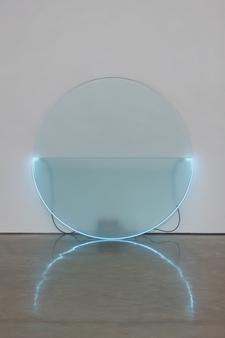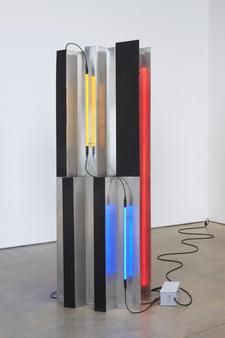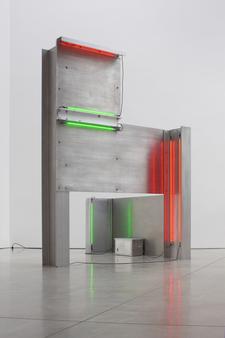
The Hall Art Foundation is pleased to announce an exhibition by American artist Keith Sonnier to be held in its galleries in Reading, Vermont from 9 May – 29 November 2015. This survey brings together a focused selection of Sonnier’s early neon works from 1968 - 1989. The use of neon has become a defining element in Sonnier’s sculpture, forming a signature and important body of work.
Beginning in the late 1960s, Sonnier radically called into question the traditional concept of sculpture by incorporating unconventional and industrial materials in his work. These “non-art” materials included fluorescent light, liquid plastic, latex, satin, bamboo, cheesecloth, string, wire and foam rubber, among others. Sonnier’s interest in unorthodox materials extends beyond their formal qualities. Through his combination of diverse elements, Sonnier evokes cultural, narrative and spiritual associations, infusing his work with an inner-life.
“I think we were amazed that what we were making would even be bought. Our type of work was somehow counter-culture. We chose materials that were not “high art”. We weren’t working in bronze, or paint, even. We were using materials that weren’t previously considered art materials. They were deliberately chosen to psychologically evoke certain kinds of feelings.” – Keith Sonnier
Sonnier began working with neon in 1968. His affinity for neon dates to his youth in Louisiana where he recalls having had an almost religious experience, when, returning one evening from a party, he drove through the level country interspersed with billboards and suddenly saw ‘waves of neon light’ move up and down in the dense fog.
In Lit Circle Blue with Etched Glass (Lit Circles Series) (1968), a tube of curved blue neon parallels the bottom edge of a circular, etched piece of glass leaning against the wall. The glow of neon transforms the simple geometric shape, giving the space around it an ethereal quality, while emphasizing a relationship between the wall and floor, which reflects the light cast by the neon curve.
Neon Wrapping Neon with Six Loops (1969) is an example of Sonnier’s first neon wall sculptures. Thin orange and pink neon tubes traverse the top of the piece, encircling two incandescent bulbs at either end. The contrast between neon and incandescent light underscores the material characteristics of neon, which suffuses the wall around it with color. The electric circuitry made up of cables and a transformer hang below, intentionally visible. Together, the linear components produce an expressive and organic calligraphic effect very much related to drawing.
In the 1980s, after a period of having primarily focused on wall objects, Sonnier begins to incorporate aluminum in his work alongside neon and switches to freestanding form. Unlike the expressive informality of the early neon wall sculptures, these works are characterized by geometric order. Column I (1981) and Column II (1981) consist of upright sheets of corrugated aluminum onto which tubes of neon have been affixed. The aluminum relief projects and deflects the neon, creating glowing channels of light that compel the viewer to approach the object from all sides. Freestanding sculptures such as these would become the basis for several important series to follow, including Sonnier’s critically acclaimed public commissions.
In works like Kiosk II (1987), Sonnier combines neon with aluminum I-beams in monumental and freestanding sculptures. Kiosk II is composed of beams, aluminum plates, and tubes of red, green and pink neon. The overall composition is slightly asymmetrical, and although the object consists entirely of geometric shapes, the interchange of open and closed rectilinear forms, together with the reflection of neon light on the aluminum plates, creates a highly dynamic effect. Like modern-day kiosks found in airports and shopping malls, the interior of the structure includes an element resembling a counter – viewers are invited to ‘step into’ the work.
Born in 1941, Sonnier was raised in the rural, French-speaking, Cajun community of Mamou, Louisiana, 200 miles west of New Orleans. He received his B.A. from the University of Southwestern Louisiana in Lafayette, and his M.F.A. from Rutgers University. Sonnier’s work has been the subject of numerous solo museum exhibitions, including: Keith Sonnier, Fluorescent Room at the Stedelijk van Abbemuseum, Eindhoven (1970); Projects: Keith Sonnier at the Museum of Modern Art, New York (1971); Keith Sonnier: Porte Vue at the Musée National d'Art Moderne, Centre Georges Pompidou, Paris (1979); The Hara Museum of Contemporary Art, Tokyo, which traveled to the Sakura Gallery in Nagoya, the Amano Gallery in Osaka and the Armory Gallery at Virginia Polytech Institute (1984); Keith Sonnier: Neon at the Hirshhorn Museum and Sculpture Garden, Washington, D.C. (1989); Keith Sonnier at Halle Süd, Geneva (1990), which traveled from Douglas Hyde Gallery in Dublin; Keith Sonnier. Werke/Works at the Sprengel Museum in Hannover, Germany, which traveled to Kunsthalle Nurnberg, Germany, and the Kunstverein St. Gallen Kunstmuseum, Switzerland (1993 - 1994); and Keith Sonnier: Transformer – Selected Works 1968 - 2005 at The Arts Club of Chicago, IL (2005). This summer a survey exhibition, Keith Sonnier: Light Works, will be shown at the Musée d’Art Moderne et Art Contemporain in Nice. Sonnier’s architectural neon installations in public spaces have earned him wide acclaim in an international context. More than 20 important public commissions by the artist have been realized since 1981. Included among these commissions is Lichtweg (or Lightway) at the New International Airport, Munich (1989 - 1992), a permanent installation that spans the 1,000-meter walkway of moving sidewalks, linking terminals and orienting passengers in a pathway of light. Additional installations include: Kansas City International Airport (2006); Re Headquarters in Munich (2002); Pfarrexpositur St. Franziskus, Roman Catholic Church, Steyr, Austria (2002); Ronald Reagan Building and International Trade Center, Washington D.C. (1998); Bureau of the Census, Bowie, Maryland (1997); Miami International Airport (1996); Caltrans Headquarters in Los Angeles (2004); and a temporary outdoor light installation, “Ba-O-Ba Berlin”, at the Neue Nationalgalerie, Berlin (2002). Sonnier lives and works in New York City and Bridgehampton, New York.
The Hall Art Foundation in Reading, Vermont is open weekends and Wednesdays by appointment.
Appointments are available at 11 AM, 1 PM and 3 PM.
Admission is free.
Donations to help support our programming are always appreciated.
551 VT Route 106
Reading, VT 05062
For more information and images, please contact the Foundation’s administrative office at + 1 212 256 0057 or info@hallartfoundation.org. Please also find further documentation on our website www.hallartfoundation.org.
The exhibition runs concurrently with Peter Saul

Keith Sonnier
Lit Circle Blue with Etched Glass (Lit Circles Series), 1968
Neon, glass, wire/transformer
58 x 61 x 25 inches
Hall Collection
Courtesy Hall Art Foundation
© Keith Sonnier

Keith Sonnier
Lac Prison, 1981
Neon, glass and aluminum
72 x 96 x 24 inches
Hall Art Foundation
Courtesy Hall Art Foundation
© Keith Sonnier

Keith Sonnier
Column I, 1981
Neon, enamel and aluminum
79 x 32 x 16 inches
Hall Art Foundation
Courtesy Hall Art Foundation
© Keith Sonnier

Keith Sonnier
Kiosk II, 1987
Neon and aluminum
118 x 79 x 79 inches
Hall Art Foundation
Courtesy Hall Art Foundation
© Keith Sonnier
